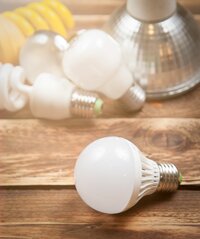The primary difference between LED bulbs and incandescent bulbs is how they produce light. A traditional incandescent bulb generates light by heating a thin tungsten filament until it glows. This process, known as thermal radiation, converts only a small percentage of the consumed energy into visible light. The majority of the energy (up to 90%) is emitted as heat.
LED bulbs, on the other hand, operate using a completely different technology. They utilize a semiconductor component, known as a light-emitting diode (LED), to emit light when an electrical current passes through it. This process produces minimal heat and converts a much higher percentage of energy directly into visible light, making LED bulbs highly energy-efficient.
The biggest advantage of LED technology is its high energy efficiency. While an incandescent bulb converts only about 10% of its energy into light, an LED bulb can utilize up to 90% of the energy for illumination. This means that far less energy is wasted as heat.
Another benefit is the extended lifespan of LED bulbs. Since they generate less heat, the components within the bulb experience less wear and tear. As a result, LED bulbs can last between 15,000 and 50,000 hours, whereas incandescent bulbs typically need replacement after only about 1,000 hours.
Although LED bulbs generate much less heat than incandescent bulbs, they still produce some heat due to their electronic components. However, this heat is efficiently dissipated through a heat sink, usually made of aluminum, which spreads the heat and prevents the temperature from rising too high.
Additionally, the lower power consumption of LED bulbs plays a crucial role. LED bulbs require significantly less wattage than incandescent bulbs to produce the same amount of light. For example, an 8-watt LED bulb provides the same brightness as a 60-watt incandescent bulb but without the excessive heat.
The lower heat output of LED bulbs provides several advantages:
Thanks to these advantages, LED bulbs are not only a more sustainable choice but also a safer and more efficient way to illuminate spaces without unnecessary heat generation.
No comments found.
